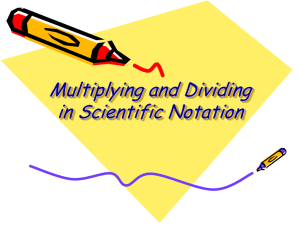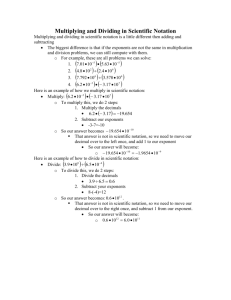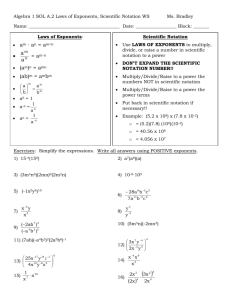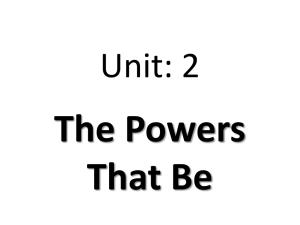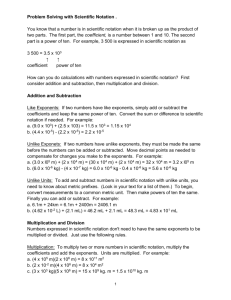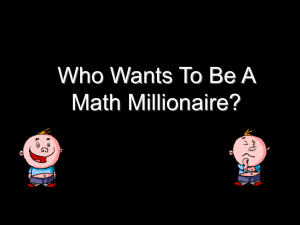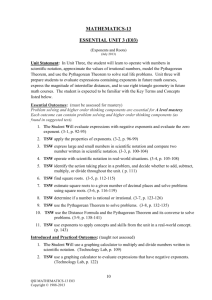notation corresponding
advertisement
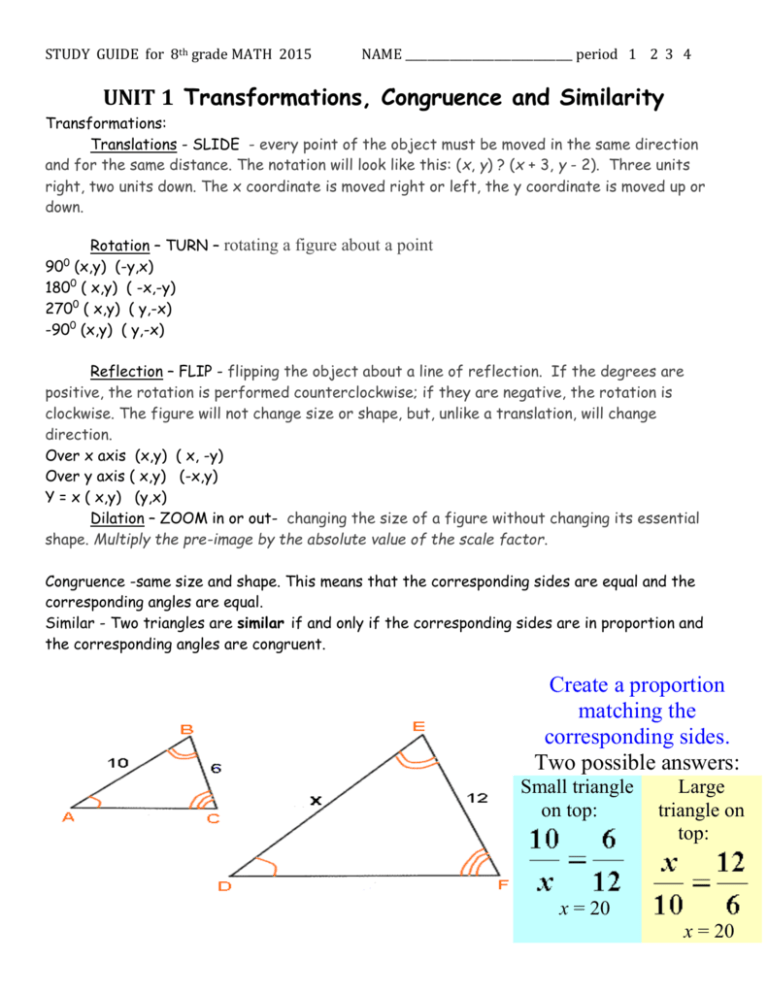
STUDY GUIDE for 8th grade MATH 2015 NAME ______________________________ period 1 2 3 4 UNIT 1 Transformations, Congruence and Similarity Transformations: Translations - SLIDE - every point of the object must be moved in the same direction and for the same distance. The notation will look like this: (x, y) ? (x + 3, y - 2). Three units right, two units down. The x coordinate is moved right or left, the y coordinate is moved up or down. Rotation – TURN – rotating a figure about a point 900 (x,y) (-y,x) 1800 ( x,y) ( -x,-y) 2700 ( x,y) ( y,-x) -900 (x,y) ( y,-x) Reflection – FLIP - flipping the object about a line of reflection. If the degrees are positive, the rotation is performed counterclockwise; if they are negative, the rotation is clockwise. The figure will not change size or shape, but, unlike a translation, will change direction. Over x axis (x,y) ( x, -y) Over y axis ( x,y) (-x,y) Y = x ( x,y) (y,x) Dilation – ZOOM in or out- changing the size of a figure without changing its essential shape. Multiply the pre-image by the absolute value of the scale factor. Congruence -same size and shape. This means that the corresponding sides are equal and the corresponding angles are equal. Similar - Two triangles are similar if and only if the corresponding sides are in proportion and the corresponding angles are congruent. Create a proportion matching the corresponding sides. Two possible answers: Small triangle on top: Large triangle on top: x = 20 x = 20 UNIT 2 Exponents Scientific notation is a compact way of writing very large and very small numbers. Standard form: 4508900000 Scientific Notation form: 4.5089 * 109 For adding and subtracting only when they have the same base and exponent. Since all numbers in scientific notation have the same base (10), we need only worry about the exponents. To be added or subtracted, two numbers in scientific notation must be manipulated so that their bases have the same exponent--this will ensure that corresponding digits in their coefficients have the same place value. Example: (4.215 x 10-2) + (3.2 x 10-4) = (4.215 x 10-2) + (0.032 x 10-2) = 4.247 x 10-2 Example: (8.97 x 104) - (2.62 x 103) = (8.97 x 104) - (0.262 x 104) = 8.71 x 104 Scientific Notation continued….. For multiplication: multiply the principal parts, and simply add the exponents of 10. Example: (3.4 x 106)(4.2 x 103) = (3.4)(4.2) x 10(6+3) = 14.28 x 109 = 1.4 x 1010 Example: (6.73 x 10-5)(2.91 x 102) = (6.73)(2.91) x 10(-5+2) = 19.58 x 10-3 = 1.96 x 10-2 For division: divide the principal parts, and simply subtract the exponents of 10. Example: (6.4 x 106)/(8.9 x 102) = (6.4)/(8.9) x 10(6-2) = 0.719 x 104 = 7.2 x 103 Example: (3.2 x 103)/(5.7 x 10-2) = (3.2)/(5.7) x 103-(-2) = 0.561 x 105 = 5.6 x 104 RATIONAL & IRRATIONAL NUMBERS – be able to place rational and irrational numbers on a number line, and estimate rational and irrational numbers. A rational number is a number that can be expressed as a fraction or ratio. The numerator and the denominator of the fraction are both integers. When the fraction is divided out, it becomes a terminating or repeating decimal. Examples: whole numbers, integers, fractions, decimals that repeat or terminate 2 0, 4, -6, 7 , .875 (terminates) . 3333333 (repeats) An irrational number cannot be expressed as a fraction. Irrational numbers cannot be represented as terminating or repeating decimals. Irrational numbers are non-terminating, non-repeating decimals. Examples: √2 ( non perfect square roots) 𝜋 (pi), .12122122212222….(keeps going on forever) PERFECT SQUARE ROOTS & PERFECT CUBE ROOTS Perfect squares 3 √1 = 1 √8 = 2 3 3 √27 =3 3 √64 =4 3 √125 =5 √216 =6 3 3 √343 =7 √512 = 8 3 √729 =9 3 √1000 =10 3 Linear equations with ONE, NO SOLUTION & INFINITLEY MANY SOLUTIONS It is possible to have more than solution in other types of equations that are not linear, but it is also possible to have no solutions or infinite solutions. No solution would mean that there is no answer to the equation. It is impossible for the equation to be true no matter what value we assign to the variable. Infinite solutions would mean that any value for the variable would make the equation true. One solution: 2x + 7 = 23 (subtract 7 on both sides) 2x = 16 (divide by 2) x = 8 No solution: 3x + 5 = 3x - 8 ( subtract 3x on both sides) 5 = -8 false statement ---NO SOLUTION X + 2x + 1 = 3(x+2) + 3 distribute by multiplying 3 to the parenthesis X + 2x + 1 = 3x + 6 + 3 combine like terms 3x + 1 = 3x + 9 subtract 3x on both sides 1 = 5 false statement NO SOLUTION Infinitely Many Solution: 4x + 9 = 4x + 9 (subtract 4x on both sides) 9 = 9 True statement INFINITE MANY X + 2x + 3 + 3 = 3 ( x+ 2) distribute by multiplying 3 to the parenthesis X + 2x + 3 + 3 = 3x + 6 combine like terms 3x + 6 = 3x + 6 both sides of the equation are the equal . True statement = infinite many solutions! UNIT 3 Geometric Applications of Exponents Pythagorean theorem a2 + b2 = c2 works only on right triangles: 32 + 42 = ? C hypotenuse A - Leg a = 3 (leg) b = 4(leg) c =?(hypotenuse) 9 + 16 + ? B leg √25 = 5 On the coordinate plane make the line segment into a right triangle, then use the Pythagorean theorem. 122 + 42 =C2 there are 12 spaces on the bottom of triangle and 4 spaces on the side of the triangle. 144 + 16 = C2 √160 = C2 12.6 ≈ C REAL World Application of Pythagorean theorem: A2 + B 2 = C2 122 + B2 = 132 144 + B2 = 169 -144 -144 B2= √25 B=5 VOLUME of Cylinders, Cones & Spheres volume is always measured in cubic units. Cylinder Volume Formula V = 𝜋 r2 h V = 3.14 * 22 * 4 V = 50.24 cm3 Cone Volume Formula 1 V = 3 𝜋 r2 h 1 V = 3 * 3.14 * 32 * 7 1 V = 3 * 197.82 ( divide by 3) V = 65.94 cm3 Sphere Volume Formula 4 V = 3 𝜋 r3 4 V = 3 * 3.14 * 143 V = 4 * 3.14 * 2744 V = 34464.64 ÷ 3 = 11488.2 cm3 Unit 4 FUNCTIONS Function - is a relation between a set of inputs and a set of outputs with the property that each input is related to exactly one output. Relation is any set of ordered pairs. All functions are relations, but not all relations are functions. FUNCTION NOT a FUNCTION FUNCTION Which ones are functions? Which ones are not functions? The domain is the set of all first elements of ordered pairs (x-coordinates).also called input, independent. The range is the set of all second elements of ordered pairs (y-coordinates), also called output, dependent. Function notation- f(x) F(x) = 4x – 2 a fancy way of saying y. X= 2, 7, 12 F(x) = 6, 26, 46 can you find f(x) when x = -13 f(x) = ________ Output value input value When comparing functions look at the rate of change or slope and the y-intercept. y = 2x + 4 to y = 8x – 5 which has the greatest rate of change? ____________ which has the greatest y-intercept? ______________ where do the lines intersect? _____
